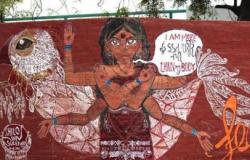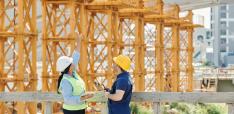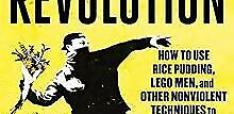Imagine a Feminist Village of the Future

On the last day of the AWID International Forum in Brazil, more than two thousand women came together to help imagine a feminist future, and to look at the hard realities of getting there.
The final morning plenary transcended all expectations. In contrast with the flashing lights and lively music which greeted our arrival on the first two mornings, this event was shrouded in darkness. Intentionally. Because the darkness was going to be lit up with the poetic re-imaginings of eight intergenerational women who took the Yoruba proverb ‘It takes a village…’ to imagine what a feminist village of the future would look like. The direction of travel imagined would involve being released from fear into hope and revolution. Shilo Shiv Suleman, one of the members of Fearless Collective, a global network of young activists and artists, and co-coordinator of the session with Nida Mushtaq, began with a poem about fear and how it had consumed her:
Fear told my father to love me with his fist
I learnt to protect myself
Fear told my mother that she had to keep her wounds to herself
I learnt to protect myself
But one day, looking up into the clouds, she said to her friend that there was a boat in the sky. Her friend did not ask, ‘what boat?’, she simply said ‘let’s use it to get away.’ It was with that suspension of disbelief that the gathering was invited to cross the threshold into that feminist village.
Nida Mushtaq took up the thread and imagined a village where there are no drones in the sky, where rooms have no doors, where there are no mirrors and where we are reflected in human faces. Nidhi Goyal, a blind woman, modified rooms with no doors to a house with revolving doors, although she added that she was speaking metaphorically because they are not wheelchair friendly. Dilar Dirik, from the Kurdish Women’s Movement, was constantly interrupted by applause as she talked about the woman’s revolution taking place in Rojava, where there are actual villages practising a radical form of democracy. She felt it "is important to implement our utopias in the here and now. We must never postpone the future."
They imagined villages of peace, justice and security, with mountains, forests and water, places of pleasure and joyful expressions of sexuality. It was Nidhi Goyal who made a riotous appeal for women’s sexual pleasure to be freed from the triple ‘C’s: control, controversy and contestation, but not the ‘C’ for condom. Coumba Toure imagined a village where there would be a genuine sharing of natural resources. "In this village we only share water, we don’t sell it’ where even lying down and looking at the stars would count as work." In this time of flood, we have created a new geography’ said the Fearless Collective. And then, only in the way that women can hold two parallel worlds in their head, the rest of the conference was made up of a series of discussions of the hard realities that lie between us and these dreams.
At a time of climate crises, we cannot avert our faces from the storm raging on the horizon especially given its disproportionate impact on women. Although the disasters both happening now and waiting to happen implicate us all, the women taking the lead on this issue appear to be indigenous women, rural women and island women mainly from the Global South. As Noelene Nabulivou, of Diverse Voices and Action for Equality (DIVA) from Fiji reminded us some of their islands will disappear in the next 30-50 years. "This is a feminist priority right here and right now not some kind of millennial end of the world scenario," she warned, "But we are not truly thinking about getting together on this and how to shift this."
Huge damage to the environment under the guise of development continues as a result of the work of extractive industries which remove gas, oil, minerals and metal from the ground. Even the World Bank was recently moved to produce a report on mining in Congo which looked at the link specifically between mining and sexual violence. First the burden of labour shifted from men to women. Agricultural communities lost their fields, which had been worked by the men; ‘what has changed now is that the fields no longer produce anything and our husbands are no longer working’ said a woman mineral transporter. These jobs were replaced by transporting minerals, ‘women’s work’.
Militarisation of the extraction process in many countries has led to huge conflicts between communities, civil war even. In Congo, it was the other way around – war led to the collapse of agriculture and mining provided a quick turnaround with cash in hand. Rape is commonplace. "There is lots of hunger here. But if you have been raped on your farm, you will never return, and the farm will just die." Much of the work that is left in the mines for women is prostitution. Interviewees for the report alleged that "you will see women climbing up towards the mines with their mattresses, and while you may think they are soldiers’ wives they are really prostitutes."
Climate change is a huge challenge but so is funding for women’s organisations. It is one of the contradictions that women have had to deal with – especially when the content of your work threatens the established order, how do you raise funds without compromising the work? It is not feasible to do sustained political work over a long period of time without paid workers and without funds. In a session on a little known UN Fund, called the Global Acceleration Instrument for Women, Peace and Security programmes, which has been set up in February 2016, Lopa Banerjee of UN Women, explained the dire state of funding for women’s organisations. Of all the money that was given to peace and security work, only 2% went towards gender equality outcomes and of that sum, only 2% was actually given to women’s organisations. This sorry state of affairs is reflected across all sectors. Most of the international funding goes to donor countries and only 8% to developing countries. There is a fear of perceived risk, financial mismanagement, weak capacity which is time consuming and takes extra resources to build and worries about how to identify the right women’s organisation in the South.
Besides, funding brings headaches. Recipients are facing huge volumes of paperwork compared to 20-30 years ago. Outputs have to be monitored and quantified in ways that often don’t make sense, for example, when you have to assess the success you have had in helping a woman leave a violent relationship, if on that occasion she hasn’t actually left. Measuring impact is the holy grail for funders but a slowly tightening noose around the neck for organisations. Among donor agencies, there is a preference to fund larger organisations in order to meet their targets because they want to deliver impact quickly. A lot of smaller organisations doing radical work get left out as a result. Donors are often not interested in infrastructure but particular outcomes. There needs to be a change of emphasis from technical to political in assessments of whether organisations are achieving transformation.
AWID has been focussing on resources, understanding where the money is coming from, where it is going, which issues are being supported and which aren’t? In a pre-forum webinar, AWID members explained the importance of data in resource mobilisation, and collective strategizing. Taking the data to funders has resulted in bringing in more money into the movement. They have developed various toolkits: to promote data collection which can be used by organisations to hold funders accountable at the local level; an impact mapper which allows for the easy collection of unanalysed stories which provide qualitative evidence of transformative change; and holding funders accountable through developing the FundHer scorecard to assess how well they’re doing on funding women’s organisations.
The AWID conference has operated on both levels: giving women space to imagine the unimaginable while providing the tools to convert that into reality; keeping our heads in the clouds while making sure we don’t stub our toes on the footpath.
Rahila Gupta is a freelance journalist and writer. Her work has appeared in The Guardian and New Humanist among other papers and magazines. Her books include, Enslaved: The New British Slavery; From Homebreakers to Jailbreakers: Southall Black Sisters; Provoked; and 'Don't Wake Me: The Ballad of Nihal Armstrong (Playdead Press, 2013). She is co-authoring a book with Beatrix Campbell with the title Why Doesn’t Patriarchy Die? Follow her on twitter @ RahilaG This post first appeared as part of OpenDemocracy's 50.50 blog series. It is part of 50.50's in-depth coverage of the 2016 AWID Forum being held on 8th -11th September in Bahia, Brazil.
Lead image: http://fearlesscollective.tumblr.com/
All other images by Rahila Gupta.





